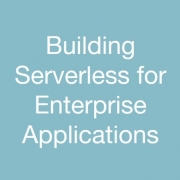Building Serverless for Enterprise Applications
If you’re reading this, you must have already become curious about serverless computing or perhaps you just read our other article on the topic. There is no doubt that the future of computing will not have any traditional servers in it. In fact, I would venture to guess that by 2025, nearly every new development project will be a serverless project. This is not very hard to believe given that we at Nogalis have been developing all our enterprise applications for the past year using this paradigm and have yet to come up with a real reason to spin up a server.
There are a few things you need to understand about “Serverless” before you can start your project.
- Firstly, your current server-bound applications cannot run serverless without going back to the drawing board. In an ideal Serverless application, each request needs to stand on its own. Each request needs to process within a single function, verify itself and its caller’s authentication and permissions, run to completion, and set the states as needed. Your current application doesn’t do that. Your server is likely holding on to user sessions that have been authenticated and running so that it can handle the user’s next request. Without getting any more technical, the important things to understand is a “Serverless” application has to be designed and developed that way, it cannot be ported over magically. At least not today in 2019.
- Most, if not all enterprise applications deal with a database. AWS has made some great strides in the area of “Serverless” databases and at the current time (2019) offers two database options that are serverless:
- Amazon DynamoDB – Amazon’s own NoSQL database service
- Amazon Aurora Serverless – an on-demand, auto-scaling configuration for Amazon Aurora (MySQL-compatible edition), where the database will automatically start up, shut down, and scale capacity up or down based on your application’s needs.
It is obvious that if Microsoft, Oracle, and IBM want to remain competitive in the DB space, they will also have to offer Serverless versions of their database products or go the way of the mainframe. In the meantime, you can build a serverless application, that connects to a server-bound database in order to store its data. We won’t judge you.
- In a serverless environment, you don’t have any local storage. Because you don’t have a, ummm, server. So, you will need to figure out your storage as a part of your design. No more writing log file to d:\temp. This is one of the biggest reasons your current server-bound application can’t just go without a server. Luckily, AWS offers several API-enabled storage solutions to deal with this limitation. Our favorite is still S3 because of its ubiquitous edge availability, it’s incredible speed, it’s flexible use cases, and its many other advanced features.
- Last on my list is the method for accessing your compute logic. For this AWS provides their API Gateway which can trigger any of your functions with ease.
Of course, the items above are not the entire story. For instance, AWS SNS is a fully managed messaging service that you can use for messaging. Cloudwatch will help you with event monitoring and debugging. A whole host of applications exist that can help with nearly everything else. In the past two years of developing serverless applications, we have yet to have a need that we couldn’t eventually resolve with AWS available services. I say eventually because our developer brains were accustomed to think of every problem in a very server-centric way. Once you stop relying on the server to solve all your development challenges, you’ll think of some innovative ways to develop your applications that will surprise you.
If you’re considering developing a serverless enterprise application, we’d love to help. Please use the contact us page to make an appointment with someone on our team to discuss your serverless project.



